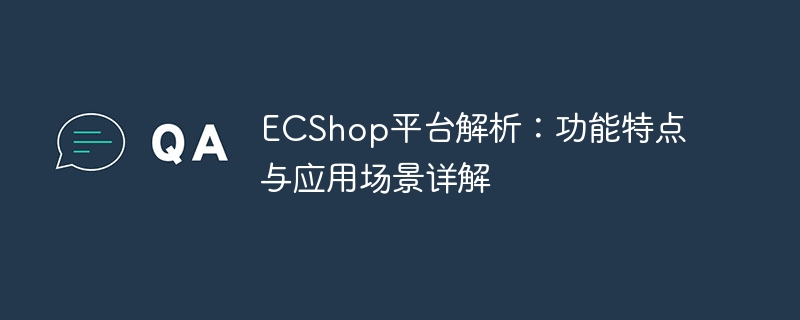Home >Backend Development >PHP Tutorial >ECShop platform analysis: detailed explanation of functional features and application scenarios
ECShop platform analysis: detailed explanation of functional features and application scenarios
- PHPzOriginal
- 2024-03-14 13:12:03611browse

ECShop platform analysis: detailed explanation of functional features and application scenarios
ECShop is an open source e-commerce system developed based on PHP MySQL. It has powerful functional features and a wide range of application scenarios. This article will analyze the functional features of the ECShop platform in detail, and combine it with specific code examples to explore its application in different scenarios.
- Functional features
1.1 Lightweight and high performance
ECShop adopts lightweight architecture design, streamlined and efficient code, fast running speed, suitable for small and medium-sized e-commerce Website Use. It adopts the MVC model and uses object-oriented programming ideas to make the system structure clear and easy to maintain and expand.
1.2 Diversified product management
ECShop provides a wealth of product management functions, including product classification, product attributes, product specifications, product inventory, etc. It supports a variety of product display methods to meet the needs of various e-commerce platforms. needs. The following is a simple product management code example:
// 添加商品
$goods = array(
'cat_id' => 1,
'goods_name' => '商品名称',
'shop_price' => 100,
'goods_number' => 100,
'is_on_sale' => 1
);
$goods_id = $GLOBALS['_Goods']->add_goods($goods);
if ($goods_id) {
echo '商品添加成功,商品ID为:' . $goods_id;
} else {
echo '商品添加失败,请重试';
}1.3 Member Management and Order Management
ECShop provides complete membership management and order management functions, including member registration, member login, member points, order generation, Order payment, etc. With the help of ECShop's member management and order management functions, e-commerce platforms can better maintain customer relationships and improve user experience.
1.4 Powerful marketing functions
ECShop provides a variety of marketing functions, such as coupons, promotions, points malls, etc., to help e-commerce platforms attract users and increase sales. The following is a simple coupon code example:
// 发放优惠券
$coupon = array(
'coupon_name' => '满100减10元优惠券',
'type_money' => 10,
'condition' => 100,
'send_start_date' => time(),
'send_end_date' => time() + 3600 * 24 * 7
);
$coupon_id = $GLOBALS['_Coupon']->add_coupon($coupon);
if ($coupon_id) {
echo '优惠券添加成功,优惠券ID为:' . $coupon_id;
} else {
echo '优惠券添加失败,请重试';
}- Application scenario
2.1 E-commerce platform
ECShop, as a mainstream e-commerce platform, is suitable for all types of A small e-commerce website provides complete product management, order management, member management and other functions. Through customized themes and plug-ins, personalized e-commerce platform construction can be achieved.
2.2 Social e-commerce
Combined with social functions, social platforms such as WeChat and Weibo can be integrated with ECShop to create a social e-commerce platform. Users can quickly expand their user base and increase sales through social sharing, social promotion and other methods.
2.3 O2O e-commerce
Integrate with offline stores to realize an O2O e-commerce model that integrates online and offline. By opening stores on the ECShop platform, functions such as online ordering, offline pickup, and offline experience can be realized to enhance user shopping experience.
Summary:
ECShop, as a feature-rich, easy-to-use and convenient e-commerce system, has a wide range of application scenarios and is suitable for use by small and medium-sized e-commerce companies and self-employed individuals. Through continuous optimization and customization, personalized e-commerce platform construction can be achieved and corporate competitiveness can be enhanced.
Through the above detailed analysis, I believe readers will have a deeper understanding of the functional features and application scenarios of the ECShop platform. I hope this article is helpful to you, thank you for reading!
The above is the detailed content of ECShop platform analysis: detailed explanation of functional features and application scenarios. For more information, please follow other related articles on the PHP Chinese website!

